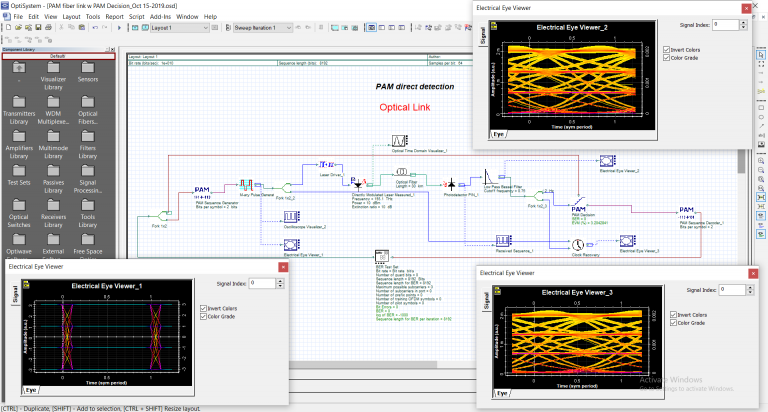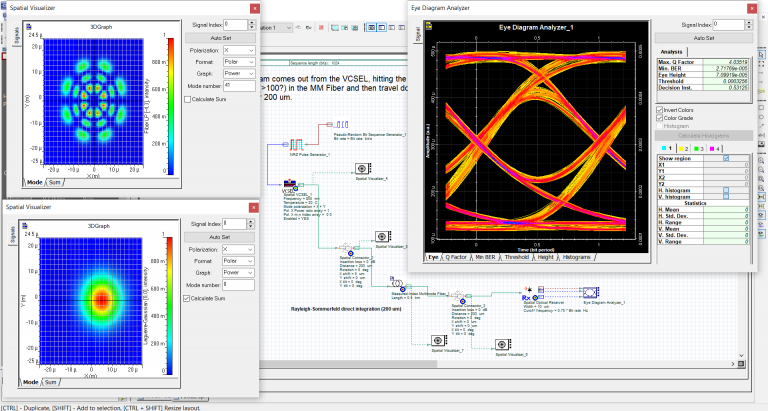
Optiwave Systems is an Ottawa based software company, boasting a robust variety of photonic design tools, which it provides to hundreds of leading high-technology institutions. Founded in 1994 and incorporated in 2005, the company has a well-established community of over one thousand users in over seventy countries. Optiwave has come to CENGN in order to validate one of their flagship products, OptiSystem, as being suitable for corporate industry use.
The Advancement of Networks Through Fibre Optics
Most networks currently use traditional copper cables on their infrastructure. They are affordable and do generally provide the speeds required by most growing Canadian businesses. However, fiber optic cables are becoming more popular within the telecommunications industry because of the growing demands for faster speeds and bandwidth.
Fibre optic cables can carry more information at a faster rate than standard metal cables. Optical cables can also be used for greater distances with little risk. Moreover, as there is an increase in data being stored wirelessly on the cloud, faster speeds are required to pull the data quickly and keeping workflows efficient.
Faster and more reliable internet can also end up being a cost-saving measure, as it can lead to higher productivity that just would not be possible with traditional networks. Fibre optics could even allow a business to increase their flexibility and scalability, due to more data and applications being easily accessible wirelessly. With the many advantages of optical networks, they are becoming more prevalent in the ICT sector. Large service providers have begun offering it to home internet subscribers, while businesses have been moving towards implementing and adopting their own private networks.
With more enterprises transitioning to optical networks, there is greater need for optical network customization and feature testing. However, a company introducing a new feature to their optical network can be risky. Unforeseen complications can lead to service disruptions and purchasing, and implementation of the wrong feature is a costly mistake. Optiwave’s solution, OptiSystem, is designed to alleviate the risks associated with the adoption of optical network technologies.
OptiSystem -Enabling Optical Network Testing
OptiSystem, first launched in 2000, is an innovative, rapidly evolving, and powerful software design tool that enables users to plan, test, and simulate almost every type of optical link in the transmission layer of a broad spectrum of optical networks.
 As networking continues to advance, so does the software design tool. In fact, Optiwave has just recently added a new feature set which enables communication and control of instruments. These additions will save customers significant money as it allows users to run experiments remotely and use OptiSystem’s huge library of visualizers and photonics components to compliment any missing components in their experimental setup. In addition, customers can replace experimental testing during system design with simulated results.
As networking continues to advance, so does the software design tool. In fact, Optiwave has just recently added a new feature set which enables communication and control of instruments. These additions will save customers significant money as it allows users to run experiments remotely and use OptiSystem’s huge library of visualizers and photonics components to compliment any missing components in their experimental setup. In addition, customers can replace experimental testing during system design with simulated results.
So far, OptiSystem’s simulated testing environments have found a niche in the academic and training sectors, providing these institutions with the ability to research optical networks without needing to purchase expensive hardware. This is specifically useful for teaching students about optical networks and training new network engineers on the wide variety of network designs supported by OptiSystem. The massive selection of applications on OptiSystem means that anyone using it can hone their skills on many different optical network configurations, making them better prepared for the workforce.
Evolving Towards New Target Markets
While the current version of OptiSystem works great for learning and research, Optiwave wants to take their solution to the next level. The company is planning on expanding OptiSystem’s market presence by better penetrating corporate and industrial sectors.
With the mass adoption of optical networks across the communications sector, there is a big need for cost-effective and low risk testing options. Optiwave wants to provide companies the ability to simulate their network and test out new configurations and functions using OptiSystem. This way, their clients can deploy and modify their networks with confidence, without having to run tests on expensive hardware.
Developing OptiSystem for Industry Application
In order to make the leap to servicing the private networking community, OptiSystem must ensure it includes all the key performance indicators found within a commercial optical network. Beyond this, each feature must be simulated with a high level of accuracy to ensure that the software is an excellent substitute.
To do this, Optiwave will be carrying out a Network Transport CENGN Project, cross checking OptiSystem’s simulated environment’s performance with the measured performance indicators from a live physical optical network. The simulation software will run on the CENGN testbed and will be compared to the results against the physical optical network to ensure system accuracy and provide a base for retuning to improve results.
The CENGN Advantage
For this project, CENGN is providing Optiwave with a bare metal server for OptiSystem to reside in. Optiwave is taking advantage of the
computing capabilities of the CENGN data centre to conduct the compute and memory hungry simulation of optical communication transmission systems. Typically, the numerical simulation of a large count DWDM system with advanced modulation over long reach takes more than 24hrs and up to a few days in some cases. The CENGN servers will allow Optiwave to conduct the simulations at no cost and get the results faster.
Optiwave is also being provisioned with a CENGN cloud tenancy, hosting a virtual machine (VM), running Prometheus for monitoring purposes. Prometheus is an open source software that records real-time metrics in a time series database, with flexible queries and real-time alerting. Optiwave wants to be sure that their solution is lightweight before it goes to market. Monitoring the usage of resources will help Optiwave identify areas that are more resource intensive than they should be, which will lead to product improvements.
Following the completion of this CENGN project, Optiwave will be equipped with the knowledge to move into the corporate market, leading to new revenue and growth. Gaining the valid comparison between a real optical network’s data and simulation results, will provide evidence on the effectiveness of OptiSystem. The team at CENGN is looking forward to giving Optiwave access to our infrastructure, and watching this well-established solution expand its potential market.
Optiwave is a growing Canadian business that is using the services at CENGN through the Next Generation Network Program (NGNP). The NGNP is a Government of Ontario program offered through a partnership between CENGN and the Ontario Centres of Excellence (OCE) that is providing small and medium-sized enterprises (SMEs) across Ontario access to the CENGN Testbed. CENGN’s digital infrastructure is connecting SMEs like Optiwave to state-of-the-art equipment and network services, which will allow these companies to test and validate their solutions.


